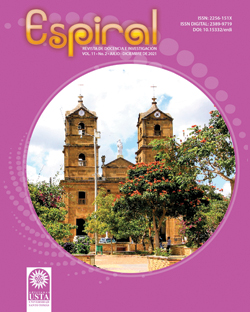Interpretación de Textos Icónicos Soportada en la Teoría de Umberto Eco y Peter McLaren
Resumen
El artículo de reflexión que aquí se presenta tiene como propósito exponer y relacionar la importancia e implicaciones de la teoría semiótica de Umberto Eco, de una parte; y de otra, el rol activo del estudiante según Peter McLaren. Se deriva de la investigación que se adelanta con el fin de fortalecer el nivel de lectura interpretativa de textos icónicos en estudiantes de quinto grado del Centro Escolar Rural “Juana Berbesí” sede “La Platanala”, en el municipio de Durania departamento de Norte de Santander. Metodológicamente corresponde a una revisión descriptiva de las teorías y conceptos propuestos por los autores mencionados, para destacar su aplicabilidad y utilidad en la enseñanza de la lectura comprensiva de textos icónicos, lo cual resulta de interés en el campo educativo y lleva a concluir que el comportamiento de estas teorías es relevante al ser aplicadas en el aula, dados sus aportes al cambio en los procesos de enseñanza de la comprensión lectora y al otorgamiento del papel protagónico del estudiante. Esta revisión se derivó del análisis del problema existente en el aula en relación con los vacíos presentes en la didáctica de la comprensión e interpretación de textos icónicos, lo cual se refleja en las limitaciones que los estudiantes presentan para interpretar y comprender imágenes, acción que conduce a descifrar el mensaje o la intención comunicativa que hay en estas. Limitante además para el desarrollo de las destrezas de expresión oral o escrita, así como de otras posibilidades con las que se estimula su imaginación y creatividad. Con base en el análisis de las propuestas teóricas de los autores en mención se logra el direccionamiento de alternativas y estrategias pedagógicas que contribuyen a afianzar la comprensión lectora de los estudiantes de educación básica primaria.
Descargas
Referencias
Arias G., D. (2013). Lenguaje y escuela en la pedagogía crítica. Actualidades Pedagógicas, (61), 97-111. doi:https://doi.org/10.19052/ap.2333
Ávila L., C. (2018) “Análisis del discurso para la comprensión e interpretación de la ironía en los textos icónicos: una lectura de la caricatura política de Osuna desde la secuencia didáctica”. Universidad de Santo Tomás, Bogotá, Colombia. https://repository.usta.edu.co/bitstream/handle/11634/15244/2018catherineavila.pdf?sequence=1&isAllowed=y
Contartese, D. (2012). Presentación de la Obra de McLaren. El socialismo y los desafíos actuales. Ediciones Herramienta, Buenos Aires, Argentina.
Correa G., J. (2016). Semiótica. Ed. Red Tercer Milenio. Tlalnepantla, C.P., Estado de México. http://www.aliat.org.mx/BibliotecasDigitales/comunicacion/Semiotica.pdf
Eco, U, (1973). Signo. Traducido por Francisco Serra Cantarell Editorial Labor, Barcelona, 1988 Segunda edición, Colombia, 1994.
Eco, U. (1973). La vida social como un sistema de signos. En: Introducción al estructuralismo. Alianza Editorial, Madrid España.
Eco, U. (1997). Tratado de semiótica general. Ed. Lumen Barcelona, España.
Farfán C., F. (2017). El método icono-verbal en el desarrollo de la comunicación oral en niños y niñas de la I.E.I. Katherine Navarrete Kalinoswki del centro poblado de Tambillo. Cusco, Perú. http://repositorio.unap.edu.pe/handle/UNAP/9818
González G., J. (2012). Intertextualidad y desarrollo de competencias comunicativas y narrativas. Revista Iberoamericana de Educación / Revista Ibero-americana de Educación ISSN: 1681-5653 n.º 60/3 – 15/11/12
Holguín A., J. (2017). Método icónico en habilidades inferencias de lectura en escolares de ocho y nueve años de edad de una institución educativa estatal de la Provincia Constitucional del Callao. Revista Científica de la Universidad César Vallejo, Perú. https://core.ac.uk/download/pdf/236064575.pdf.
Informe Nacional de Resultados para Colombia - PISA (2018) Instituto Colombiano para la Evaluación de la Educación – Icfes.
McLaren, P. (1998). Multiculturalismo revolucionario. Pedagogías de disensión para el nuevo milenio. Siglo XXI Editores, México D.F.
McLaren, P. (2012). La pedagogía crítica revolucionaria. El socialismo y los desafíos actuales. Ediciones Herramienta, Buenos Aires, Argentina.
Ministerio de Cultura (2018). Leer es mi cuento. Plan nacional de lectura y escritura (PNLE). https://cerlalc.org/wpcontent/uploads/2018/09/33 Plan_Lectura_Cultura_Colombia-2.pdf
Multiculturalismo revolucionario. Pedagogías de disensión para el nuevo milenio, México, Siglo XXI, 1998.
Organización para la Cooperación y el Desarrollo Económicos (OCDE). (s.f.). El programa PISA. ¿Qué es y para qué sirve? https://www.oecd.org/pisa/39730818.pdf
Ricceur, P. (2006). Teoría de la interpretación. Discurso y excedente de sentido. Siglo XXI Editores, México D.F. https://bivir.uacj.mx/Reserva/Documentos/rva2006151.pdf
Sánchez B., G. (2009). El uso de la imágenes en la clase e/le para el desarrollo de la expresión oral y escrita. Universidad de Estudios Internacionales de Xi´an, China. Suplementos Marcoele Núm. 8. Disponible en: https://marcoele.com/descargas/china/g.sanchez_imagenes.pdf
Tello L., A. (2016) El método icono-verbal en el desarrollo de la comunicación oral creativa en los niños de 5 años de edad: experiencia en los centros educativos del nivel inicial en el distrito de San Luis en Lima, Perú. Tesis Doctoral, Universidad Complutense de Madrid, España. https://eprints.ucm.es/id/eprint/40348/1/T38082.pdf
Valiente F., L. (2016) Leer imágenes para leer el mundo, la lectura icónica desde una estrategia pedagógica basada en expresiones artísticas en el Jardín Infantil Corpohunza. Universidad Distrital Francisco José de Caldas. Bogotá, Colombia https://repository.udistrital.edu.co/handle/11349/3721

Esta obra está bajo licencia internacional Creative Commons Reconocimiento-NoComercial-SinObrasDerivadas 4.0.
El aviso de Copyright abajo expuesto aparecerá en la sección "Sobre Nosotros" de la revista y en cada metadato de los ítems publicados. Si bien corresponde a la revista determinar la naturaleza de su acuerdo de derecho de autor con los autores, el Proyecto de Conocimiento Público (PKP) recomienda el uso de la licenciaCreative Commons. A tal fín,se proporciona el ejemplo de aviso de Copyright que puede ser copiado y pegado en el espacio inferior para revistas que (a) ofrezcan acceso abierto, (b) ofrezcan acceso abierto retardado, o (c) no ofrezcan acceso abierto.








